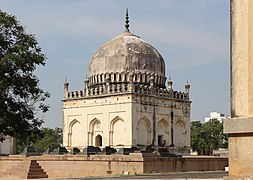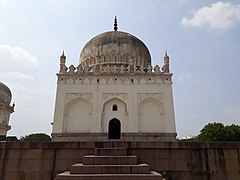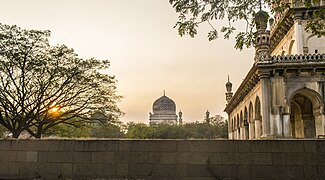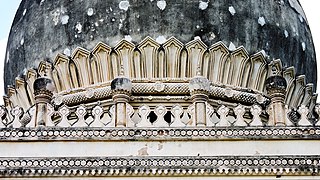Qutb Shahi tombs
| Qutb Shahi tombs | |
|---|---|
Hyderabad | |
| Coordinates | 17°23′42″N 78°23′46″E / 17.395°N 78.396°E |
| Built | 16th and 17th centuries |
| Restored | 2013–2019 |
| Restored by | Telangana State Archaeology and Museums Department, Aga Khan Trust for Culture[1][2] |
| Architectural style(s) | Indo-Islamic |
The Qutub Shahi Tombs are located in the Ibrahim Bagh (garden precinct), close to the famous
The complex was put by
Seven Qutub Shahi Tombs
Jamsheed Quli Qutb Shah srival Ibrahim Quli Qutub Shah Wali (1550-1580)
Muhammad Quli Qutb Shah (1580-1612)
Sultan Muhammad Qutb Shah (1612-1626)
Abdullah Qutb Shah (1626-1672)
Hayat Bakshi Begum (Died: 1667) She was the only daughter of Muhammad Quli Qutb Shah.
Location

The tomb complex lies north of the outer perimeter wall of Golkonda Fort and its Banjara Darwaza (Gate of the Gypsies), amidst the Ibrahim bagh.
Description
The tombs form a large cluster and stand on a raised platform. They are domed structures built on a square base surrounded by pointed arches, a distinctive style that blends
The tombs were once furnished with
History
During the Qutb Shahi period, these tombs were held in great veneration. In 1687, during the Siege of Golconda, the tombs were converted into barracks by the invading Mughal army, and the grounds were turned into a camp. Guns were mounted onto the mausoleums in order to bomb the fortress.[6]
The tombs fell into disrepair until Sir Salar Jung III ordered their restoration in the early 19th century. A garden was laid out, and a compound wall was built. Once again, the tomb-garden of the Qutb Shahi family became a place of serene beauty. All except the last of the Qutb Shahi sultans lie buried here.
21st century restoration
The Telangana State Archaeology and Museums Department, in collaboration with the Aga Khan Trust for Culture, has restored the tombs. The restoration of the stepwells within the complex was funded by the US Ambassadors Fund for Cultural Preservation.[7] The restoration work started in 2013,[8][3] and was unveiled by the U.S. Ambassador to India on 10 March 2020.[9] While restoration work paused due to the Covid-19 pandemic, work has now continued at a slower rate.[10]
Description of each tomb
Near the tomb of Sultan Quli is that of his son, Jamsheed, the second in the line of Qutb Shahi sultans. Built in 1550 A.D.,[12] this is the only Qutb Shahi tomb which has not been fashioned from shining black basalt. Its appearance, too, is quite unlike the other tombs in the garden — it rises gracefully in two stories, unlike the squat tombs of the other kings. Jamsheed Quli Qutb Shah's is the only tomb of a Qutb Shahi ruler without any inscriptions; of course, Jamsheed's son, Subhan's tomb also does not have any inscriptions. Subhan Quli Qutb Shah ruled for a short time. Subhan's tomb stands midway between the tombs of his father and grandfather. He was popularly called Chhote Malik (Small Master).
Sultan

Sultan
Another grand mausoleum is that of the sixth sultan,
The tomb of Fatima Sultan, with its bulbous dome, is near the entrance to the tomb-garden. Fatima was the sister of Muhammed Qutb Shah. Her tomb houses several graves, two with inscriptions. Immediately to the south of Muhammed Quli's tomb are three uninscribed tombs. There are the mausoleums of Kulthoom, Muhammed Qutb Shahi's granddaughter born of the son of the sultan's favourite wife Khurshid Bibi, her (Kulthoom's) husband and daughter. Kulthoom's tomb is on the west of this cluster.
The twin-tombs of the two favourite hakims (physicians) of Sultan Abdullah — Nizamuddin Ahmed Gilani and Abdul Jabbar Gilani — were built in 1651. They are among the few Qutb Shahi tombs that are not of royalty. Another pair are those of Premamati and Taramati, the favourite courtesans of Sultan Abdullah Shah, were laid to rest beside his tomb. One other tomb which is not that of a Qutb Shahi family member is that of Neknam Khan. Neknam Khan, who served in Abdullah's army, was the commander-in-chief of the Carnatic. His tomb is on a platform outside the mausoleum of Ibrahim Qutb Shah. It was built in 1672, two years after Nekam Khan's death.

The last sultan of the dynasty, Abul Hasan Qutb Shah (also known as Tana Shah), was not buried alongside his ancestor. Instead, he was buried at Khuldabad. The mausoleum which Abul Hasan, the last Qutb Shahi Sultan, began building for himself, actually houses the grave of Mir Ahmed, the son of Sultan Abdullah's son-in-law and the sister of Abbas II Safair, the Shah of Persia. The tomb of Fadma Khanum, one of Sultan Abdullah's daughters, stands near the mausoleum of her husband, Mir Ahmed. Hers is the only Qutb Shahi tomb not surmounted by a dome.
To the west of the tombs lies the dargah of

The mortuary bath, which stands opposite the tomb of Muhammad Quli, was built by Sultan Quli to facilitate the ritual washing of the bodies of the dead kings and others of the royal family before they were carried to their final resting place. The practice followed was to bring the body out of the fort, through the Banjara Gate, to this bath, before carrying it away for burial with the ritualistic pomp that was required to mark the occasion. A large number of people — relatives, officials, friends, and fond subjects — attended. The bath is one of the finest existing specimens of ancient Persian or Turkish baths.
The Qutb Shahis built a number of masjids all over Golkonda and Hyderabad, and almost every tomb has a masjid adjacent. The biggest and the grandest such masjid is by the mausoleum of Hayat Bakshi Begum. Popularly known as the great masjid of the Golkonda tombs, it was built in 1666 A.D. Fifteen cupolas decorate the roof and the prayer-hall is flanked by two lofty minarets. The impression, as a whole, is one of majesty and splendour. The inscriptions in the masjid are in calligraphic art.
Hayat Bakshi Begum was the daughter of Muhammed Quli Qutb Shah, the fifth sultan, the wife of Sultan Muhammed Qutb Shah, the sixth sultan and the mother of Abdullah Qutb Shah, the seventh sultan. She was affectionately known as "Ma Saheba" (Revered Mother). The tomb-garden of the sultans of Golkonda was known as "Lagar-e-Faiz Athar" (a place for bountiful entertainment) in the days of the Qutb Shahi rulers, for some item or song or dance or even an occasional play was staged here every evening, free of cost, to entertain the poor.
In Art and Literature
An engraving of a painting by William Purser entitled ![]() The Tombs of the Kings of Golconda. is the subject of a poetical illustration by Letitia Elizabeth Landon in Fisher's Drawing Room Scrap Book, 1838.[14]
The Tombs of the Kings of Golconda. is the subject of a poetical illustration by Letitia Elizabeth Landon in Fisher's Drawing Room Scrap Book, 1838.[14]
Gallery
-
Qutb Shahi Mosque interior
-
Distant shot of all the Qutb Shahi Tombs, Hyderabad
-
Mausoleum ofSultan Quli Qutb Shah
-
Mausoleum ofIbrahim Quli Qutb Shah
-
Mausoleum of Hayat Bakhshi Begum
-
Mausoleum of Fatima Sultana
-
Mausoleum of Kulsum Begum
-
Unfinished tomb of Nizamuddin Ahmed
-
Qibla wall in Qutb Shahi
-
Badi Baoli at Qutb Shahi Tombs
-
Sunset
-
Mausoleum of Jamsheed Quli Qutb Shah
-
Base of the dome of the mausoleum of Hayat Bakshi Begum
See also
- Golkonda
- Hyderabad, Telangana
- Charminar
- Makkah Masjid, Hyderabad
- Purani Haveli
- Taramati Baradari
References
Citations
- ^ "Restoration in Hyderabad | Aga Khan Development Network". www.akdn.org. Retrieved 5 January 2019.
- ^ Sigamany, Navin (29 April 2018). "In Images: As Hyd's Qutb Shahi Tombs reopen after 5 years, a peek into the restoration". The News Minute. Retrieved 5 January 2019.
- ^ a b "The Qutb Shahi Monuments of Hyderabad Golconda Fort, Qutb Shahi Tombs, Charminar". UNESCO World Heritage Centre. Retrieved 5 January 2019.
- ^ Restoration of Quli Qutub Shahi tombs
- ^ Archaeology Dept. increases security at Qutb Shahi tombs
- ^ Campbell, A. C. (1898). Glimpses of the Nizams Dominions. p. 252.
- ^ Chronicle, Deccan (15 September 2022). "Restoration of Qutb Shahi Heritage Park 'thrills' US Consul Larson". Deccan Chronicle. Retrieved 11 November 2022.
- ISSN 0971-751X. Retrieved 5 January 2019.
- ^ AuthorTelanganaToday. "US Ambassador unveils refurbished tombs in Hyderabad". Telangana Today. Retrieved 10 March 2020.
- ^ "Qutb Shahi Tomb Complex restoration hit by pandemic; picking up again". The Siasat Daily. 13 July 2020. Retrieved 15 July 2020.
- ^ Bilgrami 1927, p. 112.
- ^ Bilgrami 1927, p. 117.
- ^ Bilgrami 1927, p. 123.
- ^ Landon, Letitia Elizabeth (1837). "poetical illustration". Fisher's Drawing Room Scrap Book, 1838. Fisher, Son & Co.Landon, Letitia Elizabeth (1837). "picture". Fisher's Drawing Room Scrap Book, 1838. Fisher, Son & Co.
Bibliography
- Bilgrami, Syed Ali Asgar (1927). Landmarks of the Deccan. Government Central Press, Hyderabad.
External links
- Image gallery of Qutb Shahi Tombs Archived 22 October 2016 at the Wayback Machine
- Picture Archived 12 October 2007 at the Wayback Machine
- Photographs of Qutb Shahi Tombs Archived 15 March 2016 at the Wayback Machine
- Qutb Shahi Tombs pictures and spherical panoramas 360°













